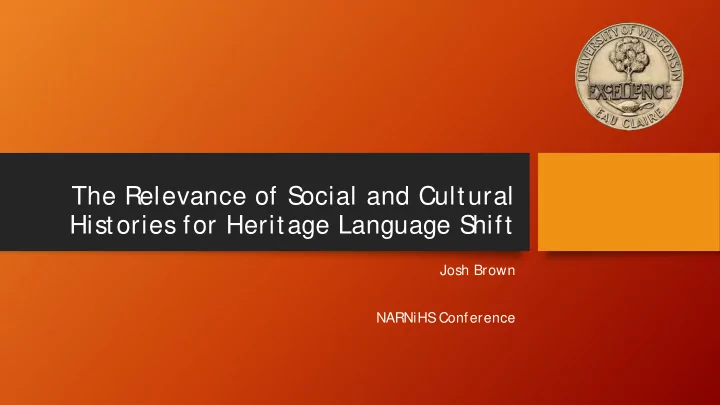

The Relevance of S ocial and Cultural Histories for Heritage Language S hift Josh Brown NARNiHS Conference
Kishacoquillas Valley
Religious spectrum
1846: Great S chism
Amish-Mennonites 1846: Maple Grove (Belleville) 1896: Locust Grove and Allensville
Verticalization • Changes to community structure bring language of vertical levels into the community • Modernity in sociology and anthropology is a “rupture in historical consciousness” (Wagner 2001) • Two levels of social reality (Berger et al. 1973) • (1) structure • (2) consciousness
Comprehensive sociohistorical view • For historical sociolinguistics (Bergs 2005, Raumolin-Brunberg 1996) • Ego-materials, metalinguistic discourse (Elspaß 2007, Horner & Rutten 2016, van der Wal & Rutten 2013) • Ethnography: S emi-structured interviews, census, church histories, newspapers, autobiographies, participant observation
“Be not conformed to this world.”
Language Outsiders English Family Neighbors Shopping List Playground Pennsylvania Dutch Books Classroom Spoken Liturgy W ritten Liturgy Archaic German
Language S hift Locust Grove Maple Grove Allensville English English English 1930 1940 1910 1920 1870 1880 1890 1900 1840 1850 1860 Great S chism Maple Grove English & German Locust Grove English & German Allensville English & German
Changes in language Narrator 1: I wanted to talk English, so I would talk English to my mother. Pop and I talked Dutch until I was in my mid-teens, I suppose. But when we’d be away somewhere, my father and I, around town somewhere, and he’d talk Dutch to me, I didn’t like that. Interviewer: Oh, you didn’t like that ? Narrator 1: I didn’t want people to know that he was talking Dutch to me.
Changes in beliefs
Changes in beliefs • “Some omish weaman S prang to their feet & S aid the[y] felt so happy that the[y] were S hure of going to Heaven if they were to die. did you ever hear of such talk in omish churches. S uch people you may set down as Religious Cranks as they have no S ense anough to Know that they are Blasfeaming the word of their maker” – John Hooley, 1897 • Revivalism increases mission work and Biblical literacy
Changes in architecture
Changes in architecture
Changes in architecture Wedding at Locust Grove, Belleville Times , January 7, 1909
Changes in music
Changes in dress
Changes in dress Narrator 1 : S ome of those things, I think the leaders were very sincere and felt they should have those restrictions for the good of the people. But I think we found to our dismay or regret that some of those things did not make anybody any better. Dressing a certain way doesn’t make a person any better.
Changes in social networks
Changes in social networks
Changes in language beliefs Narrator 2: T he whole thing that’s happening here in our community today is with the — I mean the Black Top Amish and the White Top [Amish] — is that their preachers still preach in High German and their people have no idea what they’re talking about. Narrator 37: I wanted a car. I didn’t want to battle horse and buggy. But that wasn’t the main reason. A couple times I went to Locust Grove when there was a funeral and I decided I wanted to go to a church where I could understand what the preacher was saying.
Changes in language beliefs Narrator 6: An outsider didn’t feel comfortable [in church]. Interview: By outsider you mean someone who wasn’t Mennonite or Amish? Narrator 6: S ome English-speaking person
Changes in consciousness Narrator 4: We always referred to it as Allensville Mennonite from little up. But the A[mish]-M[ennonite] was always on the sign. Cemetery split: 1870 Cemetery split: 1970 Church split: 1881 Church split: 1985
Changes in consciousness
Thank Y ou! Josh Brown, PhD brownj o@ uwec.edu j oshuarbrown.com
Recommend
More recommend